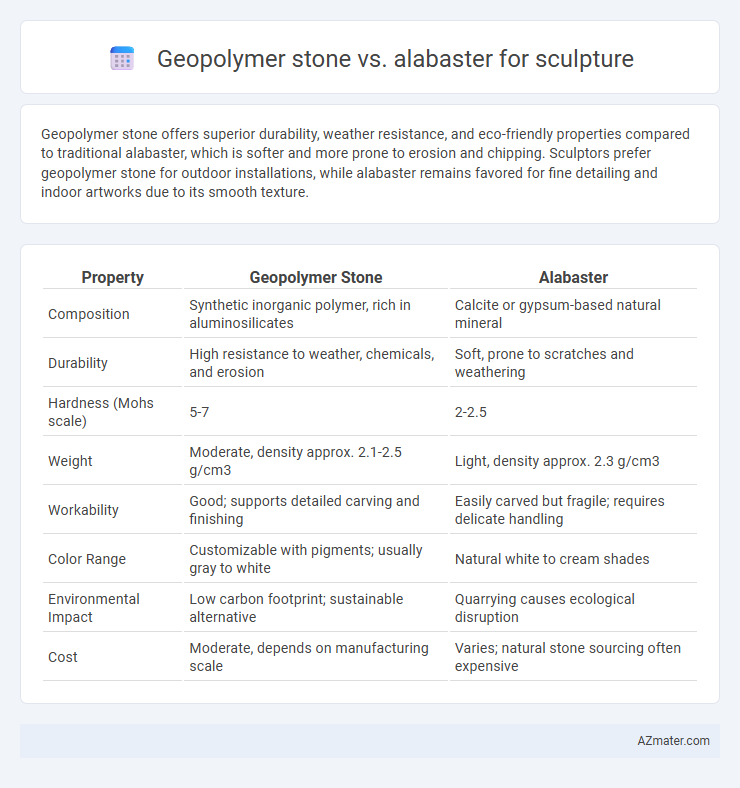Geopolymer stone offers superior durability, weather resistance, and eco-friendly properties compared to traditional alabaster, which is softer and more prone to erosion and chipping. Sculptors prefer geopolymer stone for outdoor installations, while alabaster remains favored for fine detailing and indoor artworks due to its smooth texture.
Table of Comparison
| Property | Geopolymer Stone | Alabaster |
|---|---|---|
| Composition | Synthetic inorganic polymer, rich in aluminosilicates | Calcite or gypsum-based natural mineral |
| Durability | High resistance to weather, chemicals, and erosion | Soft, prone to scratches and weathering |
| Hardness (Mohs scale) | 5-7 | 2-2.5 |
| Weight | Moderate, density approx. 2.1-2.5 g/cm3 | Light, density approx. 2.3 g/cm3 |
| Workability | Good; supports detailed carving and finishing | Easily carved but fragile; requires delicate handling |
| Color Range | Customizable with pigments; usually gray to white | Natural white to cream shades |
| Environmental Impact | Low carbon footprint; sustainable alternative | Quarrying causes ecological disruption |
| Cost | Moderate, depends on manufacturing scale | Varies; natural stone sourcing often expensive |
Introduction to Geopolymer Stone and Alabaster
Geopolymer stone is a synthetic material composed of aluminosilicate minerals that undergo a chemical reaction to form a durable, eco-friendly stone alternative ideal for modern sculpture. Alabaster, a natural mineral composed primarily of gypsum, is prized for its fine grain, translucency, and ease of carving, making it a traditional choice for detailed sculptural work. Both materials offer unique aesthetic and structural properties, with geopolymer stone providing superior strength and weather resistance compared to the softer, more delicate alabaster.
Historical Use in Sculpture
Geopolymer stone, an innovative material developed in the late 20th century, offers modern durability and environmental benefits, contrasting with alabaster, a prized translucent mineral historically favored since ancient Egypt and Mesopotamia for its softness and ease of carving intricate sculptures. Alabaster's longstanding use in religious and funerary art highlights its cultural significance, while geopolymer stone's recent adoption showcases advancements in sustainable sculptural materials. The evolution from traditional alabaster to geopolymer stone reflects shifts in artistic techniques and material technology in sculpture history.
Composition and Material Properties
Geopolymer stone is composed of industrial by-products like fly ash and slag, creating a durable, non-toxic material with excellent thermal and chemical resistance, ideal for outdoor sculptures. Alabaster is a natural, soft gypsum-based stone characterized by its translucent quality and ease of carving but lacks weather resistance and durability compared to geopolymer stone. The synthetic composition of geopolymer stone offers enhanced structural integrity and longevity, while alabaster's traditional appeal lies in its delicate texture and light diffusion properties.
Workability and Sculpting Techniques
Geopolymer stone offers superior workability for sculptors due to its consistent texture and easy curing process, which allows for precise detailing and smooth finishes. Alabaster, while softer and easier to carve initially, can be more fragile and prone to chipping, demanding delicate hand tools and careful techniques to avoid damage. Sculptors often prefer geopolymer stone for modern techniques like casting and layering, whereas alabaster suits traditional carving and polishing methods.
Durability and Longevity
Geopolymer stone offers superior durability compared to alabaster, resisting weathering, moisture, and chemical erosion more effectively, making it ideal for outdoor sculptures. Alabaster, a softer and more porous material, is prone to scratching, chipping, and degradation over time, especially when exposed to humidity or acidic conditions. Sculptors seeking long-lasting works with minimal maintenance often prefer geopolymer stone for its enhanced structural integrity and longevity.
Aesthetic Qualities and Visual Appeal
Geopolymer stone offers a contemporary aesthetic with a smooth, consistent texture and can be tinted in various colors for enhanced visual appeal, making it ideal for modern sculptures. Alabaster, prized for its translucent quality and natural veining, provides a luminous, classic beauty that captures light beautifully and adds depth to detailed carvings. While geopolymer stone emphasizes versatility and durability in color and finish, alabaster stands out for its unique glow and organic, warm tones treasured in traditional sculptural art.
Environmental Impact and Sustainability
Geopolymer stone offers a lower environmental footprint compared to alabaster, as it is made from industrial byproducts like fly ash and slag, reducing landfill waste and carbon emissions during production. Alabaster, a natural mineral, requires extensive quarrying which disrupts ecosystems and depletes non-renewable resources. The sustainable nature of geopolymer stone, combined with its durability and reduced resource consumption, makes it a more eco-friendly choice for sculpture materials.
Cost and Accessibility for Artists
Geopolymer stone offers a cost-effective alternative to alabaster, with materials that are generally less expensive and more readily available, making it accessible for artists working within tight budgets. Alabaster, while prized for its translucency and fine grain, tends to be more costly and sourced from limited geographic regions, which can restrict availability. The ease of sourcing geopolymer components locally enhances project feasibility, especially for emerging sculptors seeking affordable yet durable mediums.
Maintenance and Preservation Needs
Geopolymer stone offers superior durability and weather resistance compared to alabaster, making it easier to maintain without frequent sealing or protection from moisture. Alabaster, being a softer, more porous material, requires careful handling, regular cleaning with non-abrasive methods, and protection from humidity to prevent etching or discoloration. Preservation of geopolymer sculptures demands less intervention, whereas alabaster sculptures benefit from controlled environments to maintain their appearance and structural integrity over time.
Choosing the Best Material for Your Sculpture
Geopolymer stone offers superior durability, resistance to weathering, and environmental sustainability, making it ideal for outdoor sculptures and long-lasting installations. Alabaster, prized for its translucent beauty and ease of carving, suits detailed indoor sculptures but is more prone to damage from moisture and sunlight. Selecting between geopolymer stone and alabaster depends on the desired sculpture's exposure, endurance, and the artist's preference for texture or translucency.

Infographic: Geopolymer stone vs Alabaster for Sculpture
 azmater.com
azmater.com